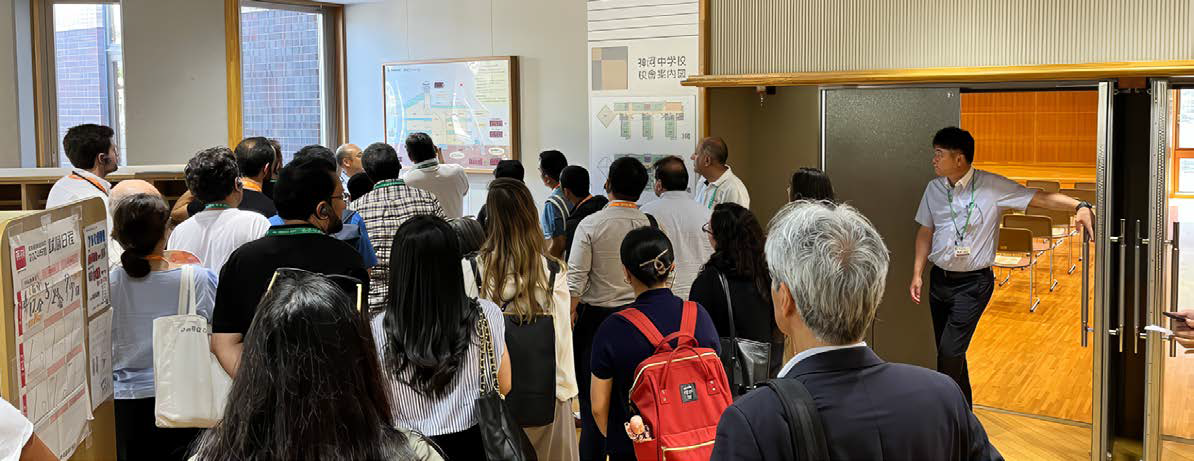By Evandro Gurgel
Amid the global learning crisis impacting low- and middle-income countries, GFDRR’s Safer Schools thematic area is leading efforts to enhance the resilience of physical learning environments worldwide. At last month’s UR24 Global Forum in Himeji, Japan, the Safer Schools team presented a two-day “Tomorrow’s Never Closed: The Future of Resilient Schools” event, exploring advanced technologies and case studies to improve school infrastructure resilience worldwide. Throughout the event, it highlighted Japan’s expertise in building safer physical learning environments, offering innovative solutions to countries facing natural hazards, and reaffirming its commitment to protecting children and ensuring educational continuity after disasters. Highlights from the main speakers included:
• Disaster risk reduction in education expert Professor Aiko Sakurai of Tohoku University, Japan, who made the opening remarks and reminded everyone of the Safer Schools thematic area’s most important goal: to safeguard the future of children.
• Visionary leader and digital innovator Dr. Umar Saif, Founder and CEO of aiSight.ai, who shared insights from his assessment of the 2022 floods in Pakistan, highlighting how technology can aid in designing resilient school infrastructure post-disasters.
• Ukraine-based futurist and AI expert Jean-Christophe Bonis, Founder of Team4ua and HIT who participated virtually and spoke about the new possibilities of 3D construction printing and emphasized the importance of prioritizing children’s needs in designing physical learning environments.
The engaging discussions that followed saw the exchange of ideas on applying these innovations to schools worldwide. The panelists included:
• Dasho Tshewang Chophel Dorji, Secretary of the Ministry of Education and Skills Development, Bhutan
• Sajad Ahmed, Joint Secretary, Ministry of Federal Education and Professional Training, Pakistan
• Revsee Escobedo, Undersecretary for Operations, Department of Education, Philippines
• Keiko Inoue, Practice Manager for Education, South Asia Region, World Bank
• Omer Elseed, Senior Education Specialist and Senior Engineer, World Bank
Omer Elseed shared insights from Africa and the United States on 3D construction printing innovations. This sparked a keen interest among participants to explore these and other new technologies for enhancing school infrastructure resilience.
The following day, a roundtable session with Japanese government officials focused on Japan’s climate change mitigation and adaptation efforts in the context of school resilience and how Japanese solutions can be applied in other countries. Delegations also had a chance to visit the Kamikawa Junior High School, an eco-friendly, earthquake-resistant school that also serves as a local evacuation center, and Muraoka Elementary School, a modern “wooden school” designed to withstand floods and landslides. The visit was accompanied by Nobuhiro Imai, CEO of Gendaikeikaku Architectural & Planning Office, who designed Muraoka School. On the bus ride back to the venue, the delegations reflected on the lessons learned that day and their applicability in the contexts of their own countries.

Photo Credit: World Bank
The Pakistani delegation noted, “The best takeaway for us today was the low-cost retrofitting techniques that can be applied immediately, such as improved indoor ventilation and lighting through appropriately placed windows. The pumping of outside air through the basement for
cooling before directing it into the building, and the creation of personalized learning environments for students through classroom redesign and furniture arrangements are cost-efficient solutions worth looking into.”
The Philippine delegates noted, “We are taking back with us the resilient school infrastructure design ideas, including the inclusive water, sanitation, and hygiene facilities and eco-friendly school building designs that can be integrated into the upcoming World Bank–supported Infrastructure for Safer and Resilient Schools project with the Department of Education and Department of Public Works and Highways. We were also deeply inspired by the community-based disaster preparedness and emergency response mechanisms in schools, such as the student-family reunification approach and the use of technology during earthquake drills.”
The Bhutanese delegation echoed, “We share the sentiments of the other delegations and are ready to adapt the knowledge gained in our home country. In particular, we are keen to implement some of the risk assessment mapping that was described as a first step to prioritizing retrofitting of schools for safety and resilience.”
Japan’s experience shows that schools can be safe havens for both students and the community. Each country faces unique natural disasters and has different response strategies. As we learned today, the best solutions often start with thoughtful design or retrofitting and are simple, cost-effective, and manageable by local communities,” Omer Elseed added.
Later that week, the World Bank’s Education team paid a unique visit to Serendix, a pioneering Japanese company in 3D construction printing and AI-driven resilient infrastructure design. The visit, inspired by Ogata Kaito’s presentation, allowed the team to witness firsthand Japan’s first 3D-printed buildings and precast concrete roof panels.
Throughout the global forum, UR participants visited our 360° virtual reality experience booth, “Keeping School Children Safe During an Earthquake in Peru,” an immersive experience offering a firsthand glimpse into the challenges faced by vulnerable communities worldwide and the solutions we can offer them.
Launched in 2014, the Safer Schools thematic area under GFDRR is dedicated to enhancing student health, well-being, and learning outcomes in the most vulnerable regions. It builds on the experiences and lessons learned from World Bank projects that financed important investments in safer school infrastructure in Colombia, the Philippines, and Türkiye. UR24 was an invaluable opportunity to showcase how we’re leading the charge in addressing global challenges and shaping a safer, more resilient future for students worldwide.
We are deeply grateful to everyone who contributed to the success of our participation in UR24. This achievement was made possible only through the invaluable support and collaboration of many, particularly from the World Bank Tokyo Disaster Risk Management (DRM) Hub and the Safer Schools team in Uruguay, who leveraged their existing relationships in Japan to help us connect with local partners and expand that conversation into a fruitful, enriching experience.
Thank you for helping us advance the mission of creating safer, more resilient schools worldwide. See you all next time!
